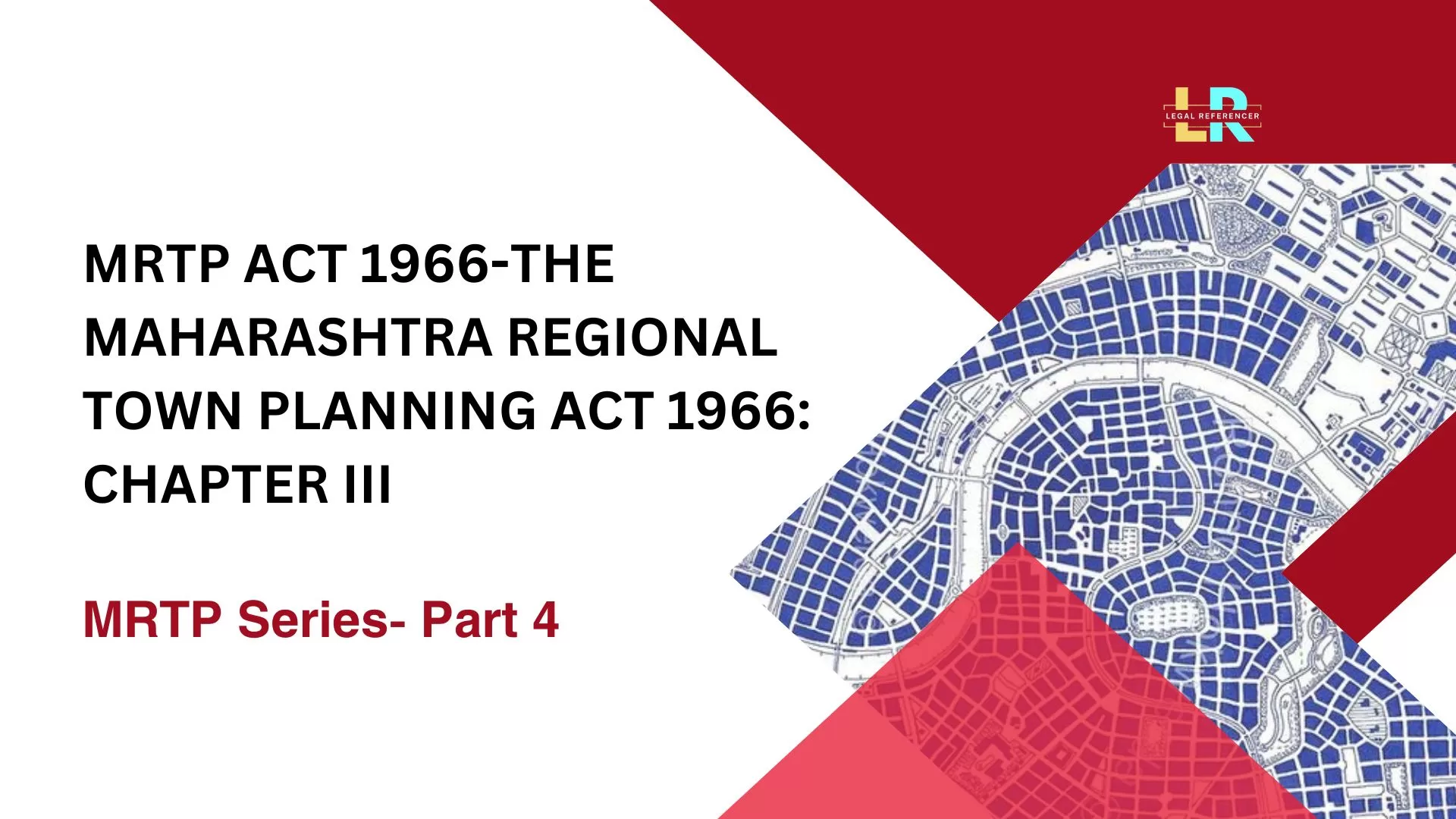DEVELOPMENT PLAN
[Declaration of intention, preparation, submission and sanction to Development Plan]
Chapter III of THE MAHARASHTRA REGIONAL TOWN PLANNING ACT 1966 (MRTP ACT 1966) deals with the preparation of development plan. It describes the procedure for declaration, modification and finalization for development plan by calling for objections. It also lays down the guidelines for revision and implementation of development plan.
Also Read: Part 1, Part 2, Part 3
21. Development Plan:
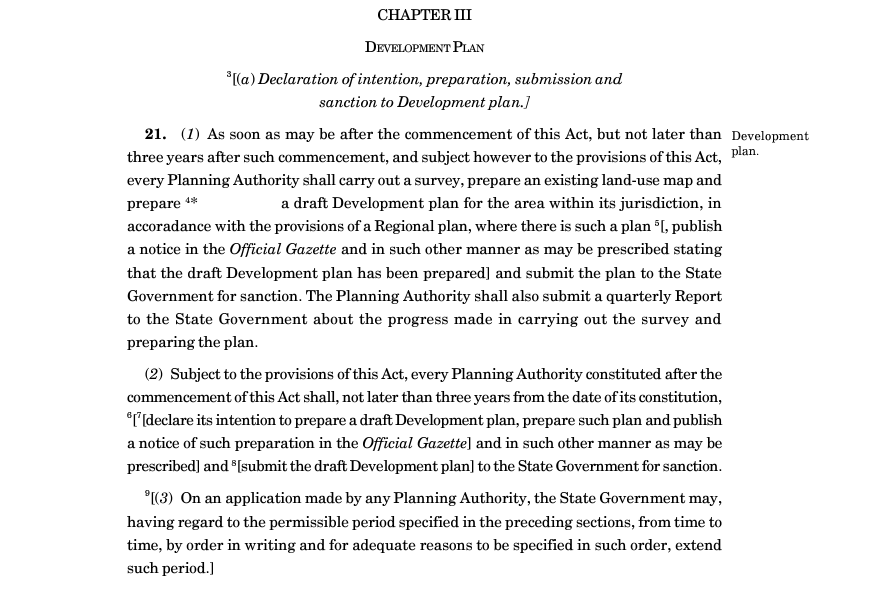
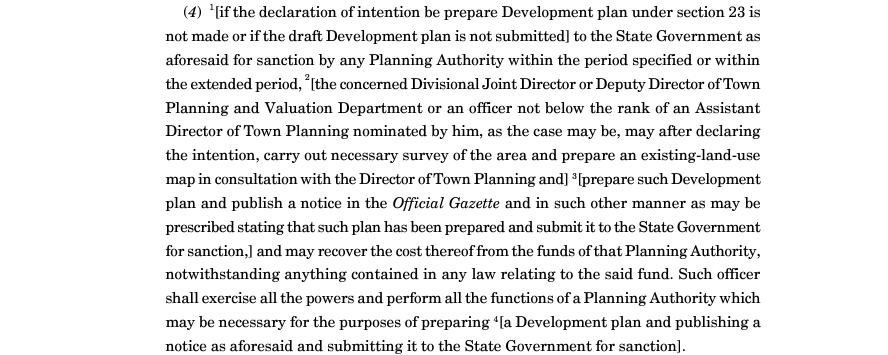


Section 21(1) of the Maharashtra Regional and Town Planning Act of 1966 stipulates an imperative for each Planning Authority operating within its jurisdiction. It necessitates the execution of a comprehensive survey, creation of an existing land-use map, and formulation of a Development Plan within a span of three years from the Act’s inception. The Development Plan’s alignment with the tenets of any existing Regional Plan, where applicable, is crucial. After preparing the draft Development Plan, the Planning Authority is obliged to officially announce its completion through the Official Gazette and other designated channels. Furthermore, the draft is submitted to the State Government for official validation.
To ensure transparency and accountability, the Act requires Planning Authorities to provide quarterly progress reports to the State Government. These reports serve as an ongoing assessment of the survey process and the gradual crafting of the Development Plan.
The Development Plan stands as a vital instrument for overseeing land usage and urban progression. It serves as a strategic framework guiding the physical evolution of a designated area, skillfully allotting land for diverse purposes, orchestrating the establishment of public amenities, and determining the trajectory of infrastructure growth. As a navigational beacon, the Development Plan facilitates the regulation of developmental initiatives. The imprimatur of the State Government ensures the Plan’s practical implementation.
Section 21(2) caters to the specific requirements of newly formed Planning Authorities. This provision mandates the declaration of intent by these entities to draft a Development Plan within three years of their establishment. This drafting process meticulously adheres to statutory directives, with a formal declaration communicated through the Official Gazette and other stipulated means. The ensuing draft is then submitted to the State Government for vital validation.
This stipulation upholds the commitment to comprehensive urban development. The cyclical renewal of the Development Plan every three years underscores a dynamic approach to addressing evolving needs and complexities while maintaining a steadfast focus on structured urban growth.
Section 21(3) introduces an essential flexibility by allowing Planning Authorities to request an extension of the allocated timeframe for Development Plan preparation and submission. The State Government assumes a crucial role in evaluating the justifications presented for this extension. If deemed reasonable, the government may grant the extension through a written decree. However, this decision is exercised judiciously, ensuring extensions are warranted by substantial and valid grounds.
The provision in Section 21(3) encapsulates a harmonious blend of rigidity and flexibility. It provides space for plausible delays while retaining an emphasis on transparent and reasoned decision-making. The written nature of this determination reinforces accountability.
The Maharashtra Regional and Town Planning Act of 1966 orchestrates a nuanced interplay between mandated obligations and procedural flexibilities. Through clauses like Section 21(3), the Act imparts a structured framework for urban planning, respecting timelines while acknowledging exigent circumstances. This approach resonates with the broader objectives of coherent urban development within the state.
Section 21 of the Maharashtra Regional and Town Planning Act, 1966, governs the pivotal aspects of Development Plans. Subsection (4) within this section caters to situations where a Planning Authority fails to adhere to mandated obligations related to the preparation and submission of a Development Plan (DDP) within prescribed timeframes.
In cases of such non-compliance, the Divisional Joint Director or Deputy Director of Town Planning (TP) and Valuation Department, or a nominated officer not below the rank of an Assistant Director of Town Planning, assumes a significant role. This officer, in consultation with the Director of Town Planning, takes charge of declaring intention, conducting required surveys, producing an existing land-use map, and subsequently crafting the Development Plan. The official then initiates the requisite Gazette notification and submits the plan for governmental sanction. Costs associated with this process can be recovered from the Planning Authority’s funds, independent of other fund-related legislation. The officer effectively wields the powers and functions requisite for these tasks, ensuring conformity with the Act’s mandates.
Subsection (4A) caters to scenarios where stipulated timeframes for specific tasks during the draft Development Plan creation process expire. The Planning Authority is considered to have defaulted on its duties under the Act in such instances. Any pending work up to the stage of draft Development Plan submission under section 30 is then entrusted to the Divisional Joint Director or Deputy Director of Town Planning and Valuation Department, or an officer of similar rank nominated by them. The designated officer exercises the necessary powers and duties of a Planning Authority for the purpose of developing the Plan and submitting it to the State Government for approval. Expenses incurred can be recouped from the Planning Authority’s funds, notwithstanding other financial legislation. Importantly, the period within which these actions are undertaken is subject to an order by the Director of Town Planning, ensuring adherence to original timelines.
Subsections (4) and (4A) of Section 21 of the Act introduce a robust mechanism to circumvent delays arising from Planning Authority inaction or non-compliance. This enables a government-appointed officer to fulfill essential procedural requirements and submit the Development Plan for validation. By doing so, the mechanism safeguards against potential developmental impediments resulting from the Planning Authority’s failure to act in a timely manner.
Section 21(5) specifically addresses scenarios wherein a local authority serving as a Planning Authority undergoes transformation through conversion, amalgamation, or sub-division. The Development Plan devised by the original Planning Authority for its area becomes the foundation for the new Planning Authority or Authorities arising from the transformation. This continuity is, however, subject to revisions and modifications approved by the State Government.
The primary intention behind this provision is to ensure a smooth and coherent urban planning process even in the face of administrative shifts within local authorities. The Development Plan serves as a guiding blueprint for land utilization and development. Ensuring its relevance and applicability post-administrative changes is imperative for maintaining developmental congruence.
In conclusion, Section 21(5) of the Maharashtra Regional and Town Planning Act, 1966 serves to guarantee the continued relevance and applicability of the Development Plan, even in instances where alterations occur in the composition of local authorities. The provision provides a mechanism for the revision and modification of the existing plan to reflect the new realities and requirements of the area, while ensuring that the principles and objectives of the Act are upheld.” rewrite as a 100 % human written content that can escape all AI detection tools including google. use simple academic language and style for rewriting which is used by professors
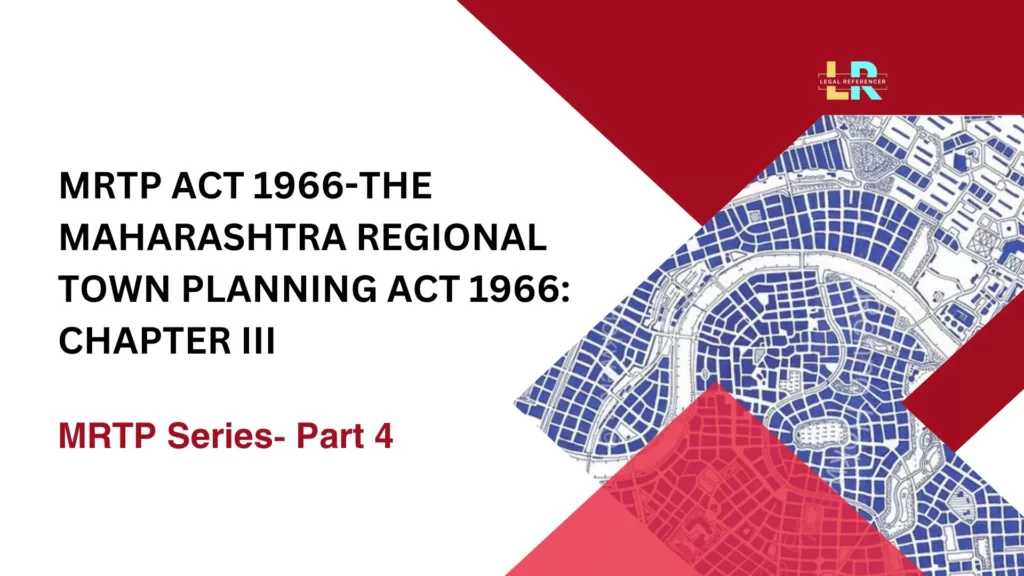
22. Contents of Development Plan:
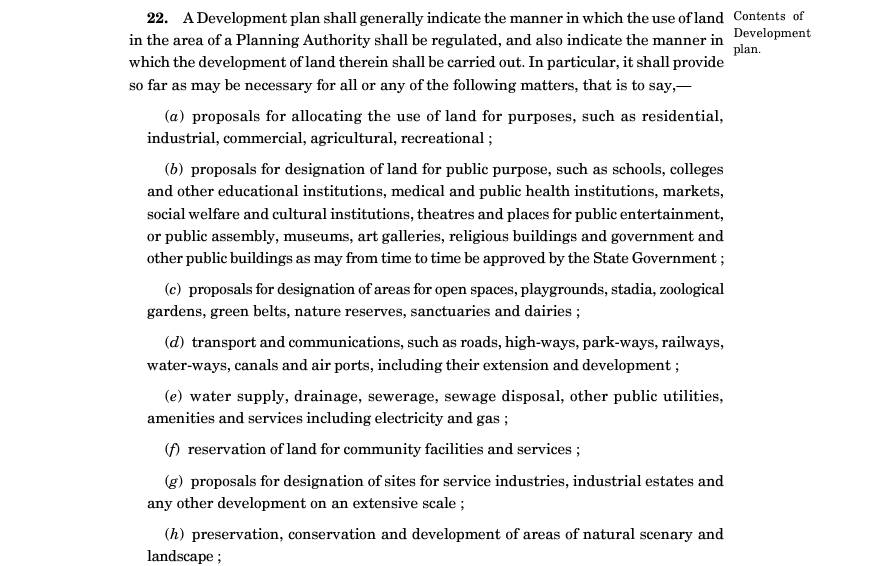

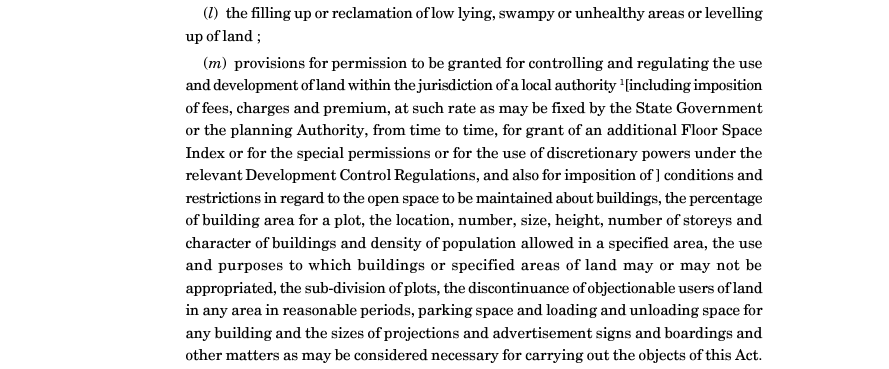
Section 22 of the Town and Country Planning Act outlines the contents of a Development Plan. The primary purpose of a Development Plan is to regulate the use of land within the jurisdiction of the Planning Authority and to provide guidelines for the development of land in that area.
The Development Plan should include proposals for allocating the use of land for different purposes, such as residential, industrial, commercial, agricultural, and recreational. These proposals should be in line with the overall development goals and objectives of the Planning Authority. The Development Plan should also identify areas for conservation and protection of natural resources, including forests, wetlands, water bodies, and other environmentally sensitive areas.
In addition to the allocation of land use, the Development Plan should also include proposals for the designation of land for public purposes, such as schools, colleges, and other educational institutions, medical and public health institutions, markets, social welfare and cultural institutions, theatres and places for public entertainment, or public assembly, museums, art galleries, religious buildings and government and other public buildings as may from time to time be approved by the State Government. The Development Plan should also identify areas for the provision of public utilities such as water supply, drainage, electricity, and other essential services.
The Development Plan should take into account the needs and aspirations of the local community, and should be prepared through a participatory process that involves public consultation and feedback. The Plan should be based on a thorough analysis of the existing conditions in the area, including demographic, social, economic, and environmental factors. It should also be prepared in accordance with the policies and guidelines of the State Government and other relevant authorities.
The Development Plan should be a dynamic document that is regularly updated to reflect changing circumstances and priorities. It should be reviewed periodically and revised as necessary to ensure that it remains relevant and effective in achieving its objectives.
Continuing from the previous answer, the Development Plan is also required to provide proposals for the designation of areas for open spaces, playgrounds, stadia, zoological gardens, green belts, nature reserves, sanctuaries, and dairies. This is to ensure that the area being planned has adequate space for recreational activities, greenery, and preservation of natural habitats.
Additionally, the Plan should also address transport and communication proposals such as roads, highways, parkways, railways, waterways, canals, and airports, including their extension and development. This is to ensure that the area is well-connected and has an efficient transportation system that can cater to the needs of the people.
The Development Plan should also provide proposals for water supply, drainage, sewerage, disposal, other public utilities, amenities, and services including electricity and gas. This is to ensure that the area has a sustainable infrastructure that can support the basic needs of the people living in the area.
The Plan should reserve land for community facilities and services, which could include hospitals, schools, libraries, community centers, and other public facilities. The Plan should also provide proposals for the designation of sites for service industries, industrial estates, and any other development on an extensive scale.
Lastly, the Development Plan should also address the preservation, conservation, and development of areas of natural scenery and landscape. This is to ensure that the natural beauty and heritage of the area are maintained and enhanced. Such measures could include the preservation of wetlands, forests, and other natural habitats.
The Development Plan is a comprehensive document that outlines the various proposals and measures required to regulate the use of land in a particular area. It provides guidelines for the development of the area and addresses various aspects such as land use, infrastructure, transport, public utilities, community facilities, and natural heritage. The Plan serves as a framework for the future development of the area and provides direction for various stakeholders, including government authorities, developers, and residents.
Preservation of features, structures, or places of historical, natural, architectural, and scientific interest and educational value: This provision requires the Development Plan to include proposals for preserving and protecting important features, structures, and places that have cultural, historical, or scientific significance. Examples of such features include ancient buildings, monuments, archaeological sites, natural landscapes, and habitats of rare or endangered species.
The inclusion of these provisions in the Development Plan is essential to ensure that the heritage and cultural values of the area are protected and preserved for future generations. These features are an important part of the cultural and historical identity of a region, and their preservation is essential to maintain the character and uniqueness of the area.
(j) Proposals for flood control and prevention of river pollution: This provision requires the Development Plan to include proposals for flood control and prevention of river pollution. These proposals may include measures such as construction of dams, reservoirs, drainage channels, and flood protection structures, and the regulation of activities that may lead to river pollution.
(k) The designation of land as subject to requisition for public purposes or as specified in a Development Plan, having regard for the provisions of section 14, or for development or for securing the use of the land in the manner provided by or under this Act, by the Central Government, a State Government, Planning Authority, public utility undertaking, or any other authority established by law: This clause mandates that suggestions for the allocation of land for public uses from various authorities be taken into account in the Development Plan. These might include creating public utilities, infrastructure, and other facilities essential to the welfare of the populace.
The final provision of the Development Plan lists a number of provisions for the regulation and control of land use within the jurisdiction of a local authority. These provisions include the power to impose fees, charges, and premiums for the grant of additional Floor Space Index or special permissions under relevant Development Control Regulations. These fees may be fixed by the State Government or the Planning Authority from time to time.
The Development Plan also provides for the imposition of conditions and restrictions on the use and development of land. These conditions and restrictions may relate to a number of factors, such as the open space to be maintained around buildings, the percentage of building area allowed on a plot, the location, size, height, number of storeys, and character of buildings, the density of population allowed in a specified area, and the use and purposes to which buildings or specified areas of land may or may not be appropriated.
The Development Plan also provides for the sub-division of plots, the discontinuance of objectionable users of land in any area within reasonable periods, the provision of parking and loading and unloading space for any building, and the sizes of projections and advertisement signs and hoardings.
All of these provisions are aimed at carrying out the objects of the Act, which are to regulate the use of land within the jurisdiction of local authorities and to ensure that development of land within those jurisdictions is carried out in a planned and coordinated manner. By providing for the regulation of land use in this way, the Act seeks to promote the health, safety, and general welfare of the inhabitants of the area, as well as to promote the orderly growth and development of the area in a sustainable and environmentally responsible manner.
The Development Plan serves as a critical tool for ensuring that land use is regulated and controlled in a way that is consistent with the goals and objectives of the local authority and the broader community. Through the provisions outlined in the Act, the Development Plan provides a framework for the responsible management of land use and development within the jurisdiction of local authorities, promoting the well-being and sustainability of communities across India.
Section 50 of the Maharashtra Regional and Town Planning Act, 1966 deals with the power of the State Government to direct the Planning Authority to modify the Development Plan or the Draft Development Plan. One of the provisions under this section states that if the State Government is satisfied that any reservation made in the Development Plan is not necessary in the public interest, it may direct the Planning Authority to delete or modify the reservation.
In the case of Keshavraj Lalchand Sakraney & Ors. v. The Special Land Acquisition Officer & Ors., 2003(2) ALL MR 923, the issue was whether the reservation made for a school in the Development Plan was liable to lapse because the land had not been acquired within the stipulated time period. The court held that the provisions of Section 50 were not applicable in this case because the State Government was not satisfied that the reservation was not necessary in the public interest.
The court further explained that if the State Government is not satisfied about the necessity of reservation in the public interest, then only the provisions of Section 50 can be invoked. However, in the present case, the State Government had not taken any decision to modify or delete the reservation. Therefore, there was no question of the reservation lapsing due to the non-acquisition of land within the stipulated time period.
In summary, the court in this case held that the provisions of Section 50 were not applicable to the present case because the State Government had not directed the Planning Authority to modify or delete the reservation. Therefore, the reservation made for a school in the Development Plan was not liable to lapse due to non-acquisition of land within the stipulated time period.
22A. Modification of substantial nature:
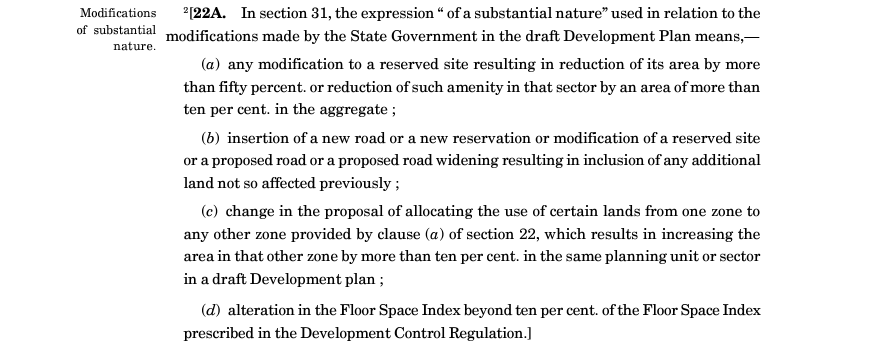
Section 31 of the Maharashtra Regional and Town Planning Act, 1966 (MRTP Act) lays down the provisions for modification of a draft Development Plan prepared by a Planning Authority. The section provides that the State Government may make modifications to the draft Development Plan submitted by the Planning Authority, but such modifications must be of a substantial nature. The expression “of a substantial nature” is defined in the section, and it refers to certain types of modifications that would be considered substantial.
The first kind of alteration listed in subsection (a) of section 31 relates to any change made to a reserved site that results in a decrease of that site’s area by more than 50% or a reduction of that amenity in that sector by an area of more than 10% collectively. This means that if the State Government makes any changes to a site that was reserved for a particular purpose, and such changes result in a substantial reduction of the area of the site or the amenity provided in that sector, then such modifications would be considered substantial.
The second type of modification mentioned in section 31(b) pertains to the insertion of a new road or a new reservation or modification of a reserved site or a proposed road or widening resulting in the inclusion of any additional land not so affected previously. This means that if the State Government makes any changes that involve the addition of new roads or reservations or modifies existing ones that were not affected previously, then such modifications would be considered substantial.
The third type of modification mentioned in section 31(c) relates to the change in the proposal of allocating the use of certain lands from one zone to any other zone provided by clause (a) of section 22, which results in increasing the area in that other zone by more than ten per cent in the same planning unit or sector in a draft Development plan. This means that if the State Government changes the proposed allocation of land from one zone to another, and such changes result in an increase of more than ten per cent in the area of the other zone in the same planning unit or sector, then such modifications would be considered substantial.
The fourth and final type of modification mentioned in section 31(d) pertains to the alteration in the Floor Space Index beyond ten per cent of the Floor Space Index prescribed in the Development Control Regulations. This means that if the State Government makes any changes to the Floor Space Index, which is the ratio of the built-up area to the total plot area, and such changes result in an alteration of more than ten per cent of the Floor Space Index prescribed in the Development Control Regulations, then such modifications would be considered substantial.
In conclusion, section 31 of the MRTP Act lays down the provisions for modification of a draft Development Plan, and the expression “of a substantial nature” used in relation to such modifications refers to certain types of modifications that would be considered substantial. These types of modifications are outlined in clauses (a) to (d) of section 31, and any modifications made by the State Government must be of a substantial nature to be valid.
The term “substantial modification” is defined in Section 22-A of the Maharashtra Regional and Town Planning Act, 1966, as any change to a draught development plan made by the State Government, including the addition of a new road, a new reservation, the modification of a reserved site, a proposed road, or a widening that includes any additional land not previously so affected.
The case of Parisar through its Secretary v. Pune Municipal Corporation, 2013 (1) ALL MR 328 dealt with a situation where the Pune Municipal Corporation (PMC) had proposed a new road in the draft development plan. The proposed road was not present in the earlier development plan and therefore it was considered as a substantial modification under Section 22-A.
The petitioner, Parisar, challenged the proposed road stating that it was not in public interest and that the PMC had not followed the procedure laid down in Section 37 of the Act for making substantial modifications.
The Bombay High Court held that the proposed road was a substantial modification under Section 22-A of the Act and therefore the PMC was required to follow the procedure under Section 37 of the Act. The court further held that the PMC had not followed the procedure laid down under Section 37 and therefore the proposed road could not be allowed.
The court observed that the PMC had not consulted the Planning Authority before proposing the new road and had not considered the objections raised by the public. The court also observed that the PMC had not conducted a proper survey of the area to assess the impact of the proposed road on the environment and public health.
In conclusion, the case of Parisar through its Secretary v. Pune Municipal Corporation, 2013 (1) ALL MR 328 highlights the importance of following the procedure laid down in the Act for making substantial modifications to a draft development plan. The case also emphasizes the need for proper consultation with the Planning Authority and the public, and for conducting a proper survey to assess the impact of any proposed modification on the environment and public health.
In this case, Motibagh Co-Operative Housing v. Pune Municipal Corporation & Ors., AIR 2005 Bom 304, 2005 (4) BomCR 549. the issue at hand was a change in reservation from the purpose of parking to the purpose of a bus depot or terminus. The court found that this change would have a significant impact on the life-style of those living in the area, as well as the ecology and environment of the area.
The court also considered the impact on the owners of the land. If the area was reserved for parking, the owners could potentially develop and retain part of the land for themselves. However, if the reservation was changed to a bus depot or terminus, the owners would no longer have that option.
The court’s decision in this case highlights the importance of considering the potential impact of changes to land use reservations. Changes that may seem minor on the surface can have significant consequences for the environment, the community, and individual property owners. Therefore, it is important for competent authorities to carefully consider the implications of any proposed modifications and follow the appropriate procedures under the law.
23. Declaration of intention to prepare Development plans:


According to this section, a planning authority must make a declaration of its intention to prepare a Development plan before carrying out a survey and preparing an existing-land-use map of the area as provided in Section 21. The planning authority shall dispatch a copy of such a resolution, along with a plan showing only the boundary of the entire area proposed to be included in the Development plan, to the State Government. The officer responsible for preparing the plan shall also make a similar declaration and submit a copy of it to the State Government. The officer in charge of preparing the plan or the planning authority must also publish a notice of this declaration in the Official Gazette and one or more local newspapers in the manner specified, inviting public comments or objections within at least sixty days of the notice’s publication in the Official Gazette. This provision ensures that the public has an opportunity to give their suggestions and objections before the Development plan is finalized.
The copy of the plan showing only the boundary of the entire area proposed to be included in the Development plan shall be open to the inspection of the public at all reasonable hours at the head office of the planning authority and local authority. This provision ensures transparency and allows the public to have access to the proposed plan.
The purpose of this section is to ensure that the process of preparing a Development plan is transparent and participatory. By making a declaration of its intention to prepare a Development plan, the planning authority or officer responsible for preparing the plan is informing the public about the proposed plan and inviting their suggestions and objections. The provision of making the plan available for inspection by the public at all reasonable hours ensures that the public is well-informed about the proposed plan.
Overall, the declaration of intention to prepare Development plans is an essential step in the planning process. It ensures that the planning process is transparent, participatory, and accountable to the public. This provision plays a crucial role in ensuring that the Development plan is prepared in a manner that is in the best interests of the public and is in accordance with the objectives of the Maharashtra Regional and Town Planning Act, 1966.
In the case of Smt. Urmilaben Jayantilal Parikh v. The State of Maharashtra & Another, the petitioners owned a plot of land which was reserved for public purposes by the development plan of the area. The petitioners approached the authorities to request for the dereservation of their plot, but their request was refused on the ground that constructions had come up on the adjacent land, which had also been reserved for public purposes. The authorities had, therefore, decided to dereserve the adjacent land instead of the petitioner’s plot.
The petitioners challenged the decision of the authorities in the Bombay High Court. The court held that the decision of the authorities appeared to be arbitrary and mala fide, as it would amount to giving benefit to those who had taken the law into their own hands and penalizing law-abiding citizens. The court further held that the decision to dereserve the adjacent land instead of the petitioner’s plot was not justified, as the adjacent land was much larger (admeasuring more than 25,000 square metres) than the petitioner’s plot, and it was not clear why it was necessary to dereserve such a large area.
The court, therefore, quashed and set aside the order of the authorities and ordered them to dereserve the petitioner’s plot. The court observed that the reservation of the petitioner’s plot was causing them prejudice, and the authorities had failed to justify the need for such a reservation. The court also noted that the authorities had not followed the proper procedure for dereservation, which required them to seek the opinion of the planning authority and the public before making any changes to the development plan.
This case highlights the importance of following due process in matters related to the reservation and dereservation of land. It also emphasizes the need for authorities to act in a fair and transparent manner and to avoid arbitrary and mala fide decisions. The court’s decision in this case ensured that the rights of law-abiding citizens were protected and that the authorities were held accountable for their actions.
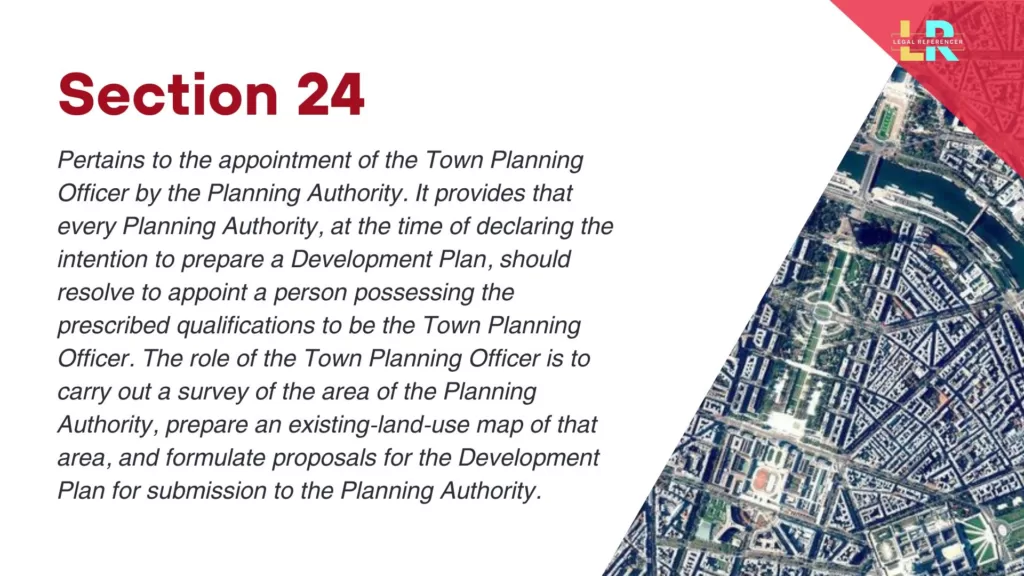
24. Town Planning Officer:

Section 24 of the Maharashtra Regional and Town Planning Act, 1966 pertains to the appointment of the Town Planning Officer by the Planning Authority. It provides that every Planning Authority, at the time of declaring the intention to prepare a Development Plan, should resolve to appoint a person possessing the prescribed qualifications to be the Town Planning Officer. The role of the Town Planning Officer is to carry out a survey of the area of the Planning Authority, prepare an existing-land-use map of that area, and formulate proposals for the Development Plan for submission to the Planning Authority.
Once the resolution is passed, the Planning Authority shall appoint the Town Planning Officer with the previous sanction of the State Government. The qualifications required for the appointment of a Town Planning Officer are prescribed by the State Government. Typically, a Town Planning Officer is expected to possess a degree in Town Planning or Architecture, with experience in the preparation and implementation of Development Plans.
The role of the Town Planning Officer is crucial in the preparation of a Development Plan. The officer is responsible for carrying out a survey of the area and preparing an existing-land-use map, which identifies the current land-use pattern and infrastructure in the area. Based on this, the officer formulates proposals for the Development Plan, which aim to guide the future development of the area in a sustainable and equitable manner. The proposals may include provisions for land use, zoning, infrastructure development, and environmental conservation, among others.
The Town Planning Officer also plays a key role in the implementation of the Development Plan. They oversee the process of granting development permissions, monitor compliance with the regulations, and undertake periodic reviews of the plan to ensure its continued relevance and effectiveness. The officer may also be involved in resolving disputes related to land-use and development, and may provide technical assistance to the Planning Authority in matters related to town planning and urban development.
The appointment of a qualified and competent Town Planning Officer is crucial for the effective implementation of the Development Plan and the sustainable development of the area.
25. Provision for survey and preparation of existing land-use map:

Section 25 of the Maharashtra Regional and Town Planning Act, 1966, provides for the provision of a survey and preparation of the existing land-use map. After the declaration of intention by the Planning Authority or the Town Planning Officer to prepare a Development plan, a survey of the lands within the jurisdiction of the Planning Authority is to be carried out. This survey is to be done within six months from the date of such declaration, and the survey period can be extended by the State Government for such further time as it may deem necessary.
The main objective of this survey is to obtain information about the lands within the jurisdiction of the Planning Authority and to prepare an existing land-use map indicating the existing use of land in the area. The existing land-use map is an essential document for the preparation of the Development plan as it helps in identifying the current use of land, the nature of land-use patterns, and the extent of development in the area. It is also used to identify areas that need to be developed and areas that need to be conserved.
The survey and preparation of the existing land-use map are done to ensure that the Development plan takes into account the current situation and identifies the areas that require development. The existing land-use map provides a basis for the formulation of proposals for the Development plan. It helps to identify the areas that need to be developed and those that need to be preserved. It is an essential tool for the Planning Authority to understand the needs and requirements of the area and to develop a plan that caters to those needs.
The period for the survey and preparation of the existing land-use map can be extended by the State Government for up to one year in the aggregate. However, it is crucial that the survey is completed within the stipulated time to avoid any delay in the preparation of the Development plan.
26. Preparation and publication of notice of draft Development plan:

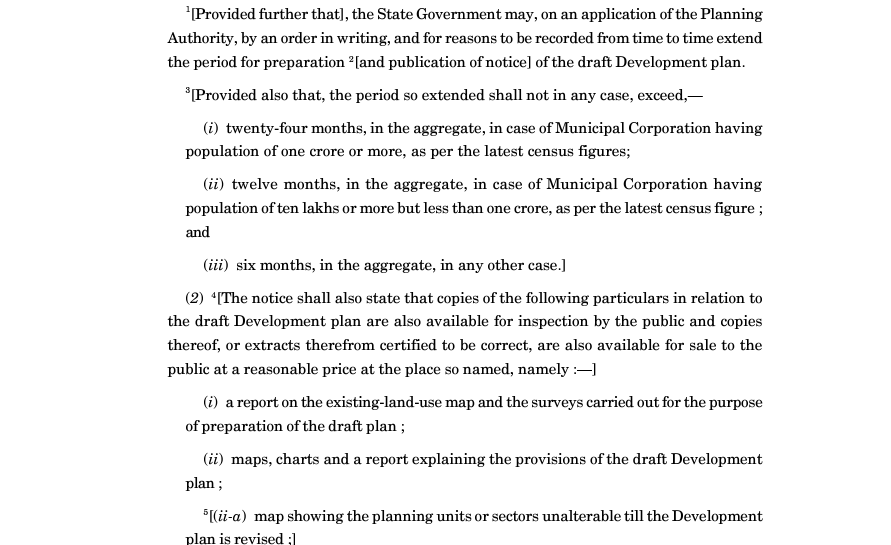

In this case, Raju S. Jethmalani & Ors.v.State Of Maharashtra & Ors., 2006(1) ALL MR 1 (S.C.). the appellants had challenged the validity of a notification issued by the State Government under section 4(1) of the Land Acquisition Act, 1894, for the acquisition of land belonging to them for the purpose of a housing project. The appellants had contended that the acquisition was not for a public purpose, and that the land was reserved for the purpose of a garden and a park in the Development Plan. The High Court had allowed the writ petition and quashed the notification, but had also directed the appellants to provide suitable area in the present locality for a garden and park, if they wished to avoid the acquisition.
The Supreme Court held that the direction of the High Court was misconceived, as the burden of providing space for a garden and park should have been placed on the Municipal Corporation or the State Government, and not on the appellants. The Court observed that the land in question was reserved for the purpose of a garden and a park in the Development Plan, and that the acquisition was not for a public purpose. The Court also noted that the State Government had failed to comply with the requirement of section 37 of the Maharashtra Regional and Town Planning Act, 1966, which required the State Government to obtain the previous sanction of the Planning Authority before acquiring land reserved for a public purpose.
In light of these findings, the Supreme Court allowed the appeals and set aside the orders of the High Court. The Court held that the acquisition of the land belonging to the appellants was illegal and invalid, and directed the State Government to return the possession of the land to the appellants. The Court also directed the State Government to pay compensation to the appellants for the loss of their land, as provided under the Land Acquisition Act, 1894.
27. Provision of Regional plan to be considered:


Section 27 of the Maharashtra Regional and Town Planning Act, 1966 provides that when an area within the jurisdiction of a Planning Authority is included in a Region, the Planning Authority or the said Officer shall have regard to and be guided by the proposals made in any draft Regional plan or any final Regional plan while preparing the draft Development plan.
The Regional plan is a comprehensive plan that sets out the broad policies and strategies for the development of the entire region. It is prepared by the Regional Planning Board, which is a statutory body established by the state government. The Regional plan takes into account the existing conditions and the future growth trends of the region and proposes a framework for the orderly development of the region. The Planning Authority or the said Officer, while preparing the Development plan, shall consider the proposals made in the Regional plan and be guided by them.
The section also states that any changes to a Regional Plan provision that the Planning Authority or the designated Officer deems necessary may be made, in the case of a draught Regional Plan, with the approval of the Regional Board, and in the case of a final Regional Plan, with the approval of the State Government.
The Planning Authority or the said Officer cannot deviate from the Regional plan without the approval of the appropriate authority. The provision ensures that the Development plan is consistent with the broader policies and strategies of the region, and the orderly and coordinated development of the entire region is achieved.
28. Objections to draft Development Plan:
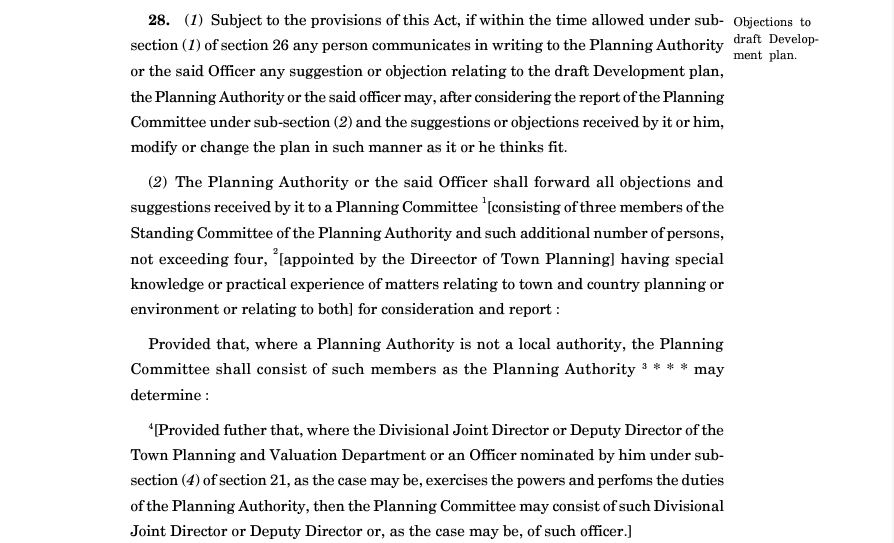

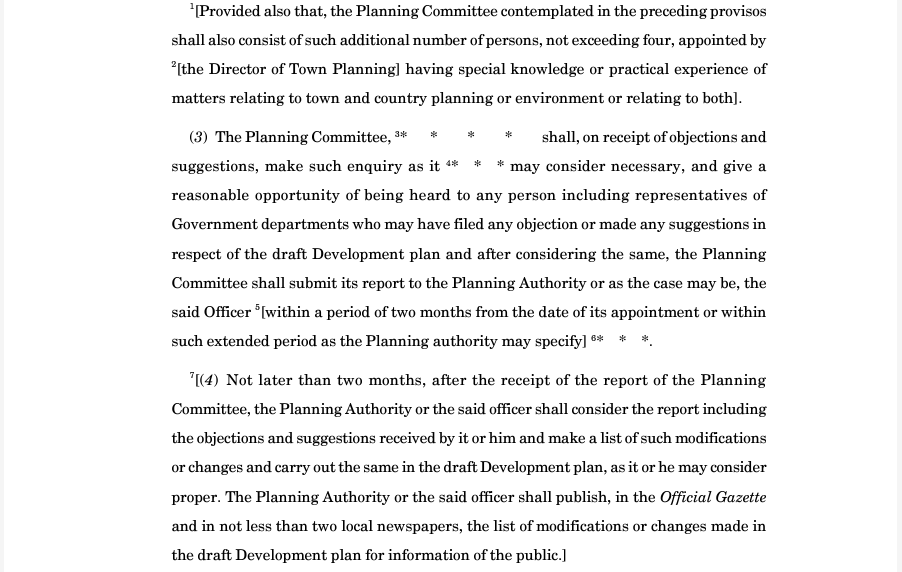
The case of Fardoon Manekji Dalal & Anr. v. State of Maharashtra & Ors. was related to the use of a parcel of land for developing a playground for children and a nursery/garden. The petitioners had raised objections to the development plan proposed by the Director of Town Planning, as it did not include the use of the land for the purposes they had suggested.
The court held that the contentions raised by the petitioners deserved to be accepted, and directed the Director of Town Planning to hear the petitioners with respect to their objections, particularly in light of their own proposals as well as the resolutions passed by the Municipal Council in the year 1987. The court emphasized that the Director of Town Planning should take into account the interests of the petitioners and consider their proposal for developing a playground for children and a nursery/garden, before finalizing the development plan.
Overall, the case highlights the importance of considering the views and proposals of the local community when formulating development plans, especially when it comes to the use of land for public amenities like playgrounds and gardens.
The Maharashtra Regional and Town Planning Act, 1966 lays out the procedure for the preparation of the Development Plan, and it also provides a mechanism for objections to the draft Development Plan. The Act states that any person can communicate their suggestions or objections in writing to the Planning Authority or the said Officer within the time allowed under sub-section (1) of section 26 of the Act. The Planning Authority or the said Officer can modify or change the plan in such a manner as they think fit after considering the report of the Planning Committee under sub-section (2) and the suggestions or objections received by them.
The Act also provides for the formation of a Planning Committee consisting of three members of the Standing Committee of the Planning Authority and such additional number of persons, not exceeding four, appointed by the Director of Town Planning having special knowledge or practical experience of matters relating to town and country planning or environment or both. The Planning Committee shall consider all objections and suggestions received by the Planning Authority or the said Officer and make such an enquiry as it may consider necessary. It shall also give a reasonable opportunity of being heard to any person including representatives of Government departments who may have filed any objection or made any suggestion in respect of the draft Development Plan. After considering the same, the Planning Committee shall submit its report to the Planning Authority or the said Officer within two months from the date of its appointment or within such extended period as the Planning authority may specify.
The Planning Authority or Officer must follow after receiving the report of the Planning Committee. They must consider the report along with any objections and suggestions received, and make a list of modifications or changes to the draft Development plan as they deem appropriate. The list of changes must be published in the Official Gazette and in at least two local newspapers to inform the public. This must be done no later than two months after receiving the Planning Committee’s report.
This procedure ensures that objections and suggestions received by the Planning Authority or the said Officer are properly considered and that modifications or changes are made to the draft Development Plan in accordance with the suggestions and objections received. It also ensures transparency and public participation in the planning process by requiring the Planning Authority or the said Officer to publish the list of modifications or changes made in the draft Development Plan.
[29. Modification made after preparing and publishing notice of draft Development Plan] [Deleted]
Section 29 was deleted by Mah. 10 of 2011, s.7
30. Submission of draft Development plan:

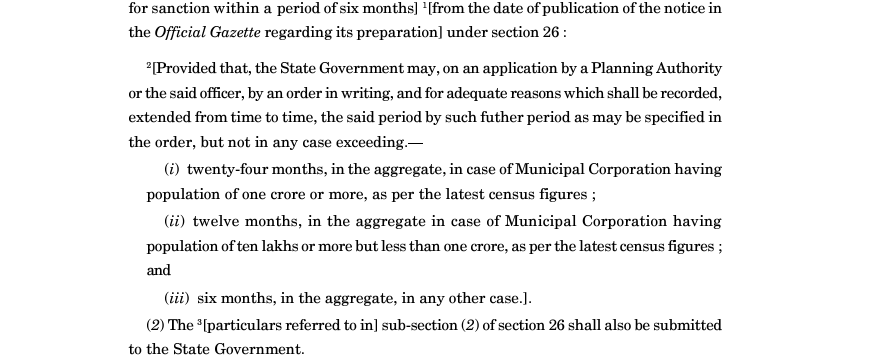
Section 30 of the Maharashtra Regional and Town Planning Act, 1966 lays down the provisions for submission of the draft development plan to the State Government for sanction. The Planning Authority or the said officer, who has prepared the draft development plan, shall submit it to the State Government within a period of six months from the date of publication of the notice in the Official Gazette regarding its preparation under section 26.
Before submission, the Planning Authority or the said Officer shall make modifications or changes in the draft development plan as per the suggestions or objections received by it or him, and the report of the Planning Committee appointed under sub-section (2) of section 28. The list of such modifications or changes made in the draft development plan shall also be submitted along with the draft plan to the State Government.
The State Government may, on an application by a Planning Authority or the said Officer, extend the period of six months by a further period as specified in the order, for adequate reasons which shall be recorded. However, such an extension shall not exceed twenty-four months in the aggregate for Municipal Corporations having a population of one crore or more, twelve months in the aggregate for Municipal Corporations having a population of ten lakhs or more but less than one crore, and six months in the aggregate in any other case.
In addition to the draft development plan, the particulars referred to in sub-section (2) of section 26 shall also be submitted to the State Government. These particulars include the existing land use, zoning regulations, proposed land use, and regulations for development and use of land, among others.
The State Government shall examine the draft development plan and may either sanction it or return it for modification, stating the reasons for doing so. If the State Government returns the draft plan for modification, the Planning Authority or the said Officer shall make the necessary modifications and resubmit the plan to the State Government. Once the draft development plan is sanctioned by the State Government, it shall be deemed to be the final development plan for the concerned area.
31. Sanction to draft Development plan:
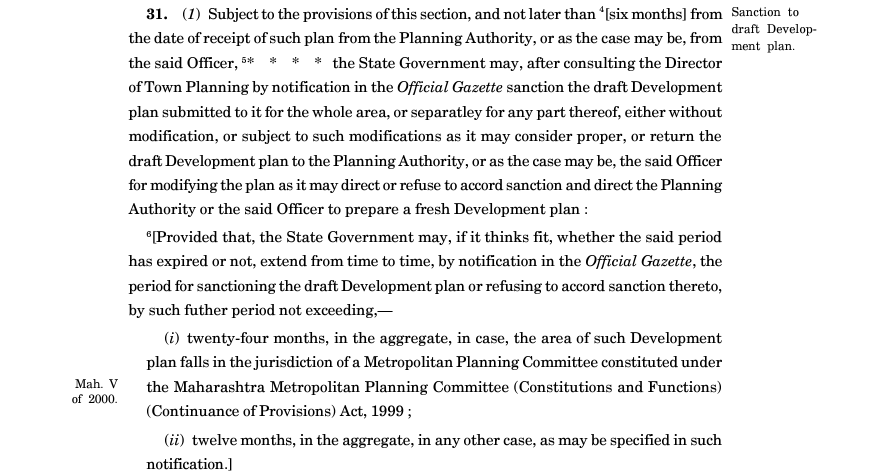
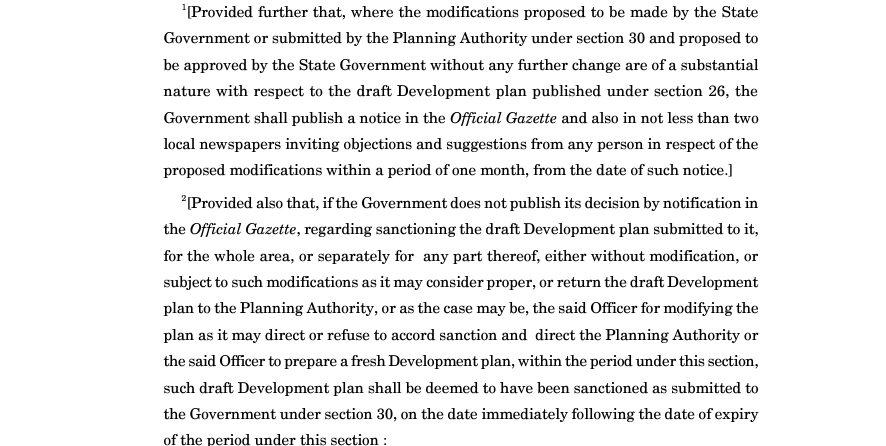
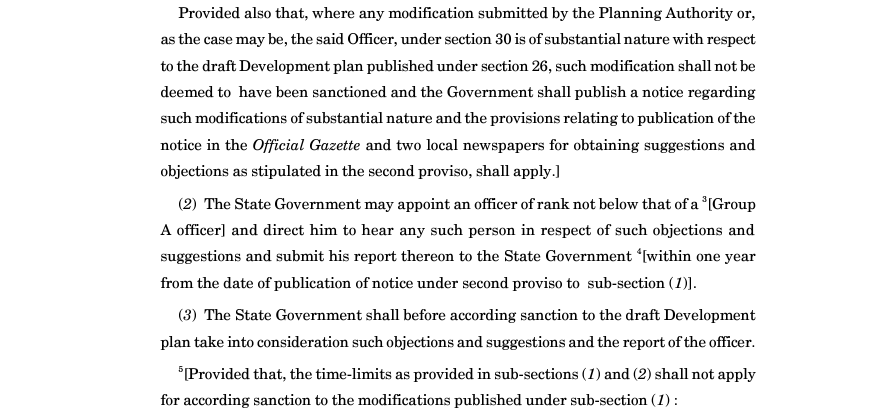
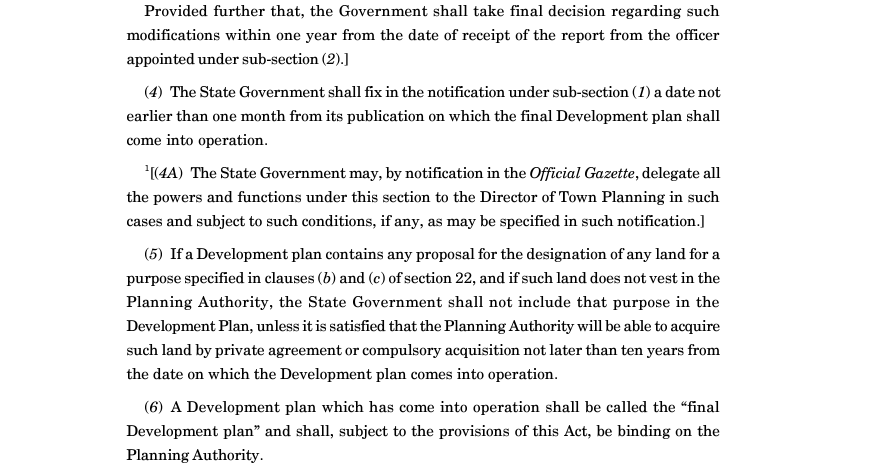
This text is a section from the Maharashtra Regional and Town Planning Act, 1966, which outlines the process for sanctioning a draft development plan.
The section states that the state government has up to six months to review and sanction a draft development plan submitted by the planning authority or officer. The government may approve the plan without modification or with modifications deemed appropriate, or it may return the plan to the planning authority or officer for further modification. Alternatively, the government may refuse to sanction the plan and direct the planning authority or officer to prepare a new plan.
There are also several provisions that allow for extensions of the six-month review period under certain circumstances. For example, if the area covered by the plan falls within the jurisdiction of a Metropolitan Planning Committee, the government may extend the review period up to a total of 24 months. In other cases, the review period may be extended up to a total of 12 months.
If the modifications proposed by the government or the planning authority are substantial in nature, a notice must be published in the Official Gazette and two local newspapers, inviting objections and suggestions from the public within one month.
Finally, if the government fails to make a decision on the plan within the specified period, the plan will be deemed to have been sanctioned as submitted. However, if substantial modifications have been proposed, they will not be deemed to have been sanctioned, and the notice and objection process will apply.
This section pertains to the process of obtaining sanction for a draft Development plan in the state of Maharashtra, India.
Sub-section (1) states that within six months of receiving the draft plan from the Planning Authority or Officer, the State Government may either sanction the plan without modification, sanction it with modifications, return the plan for modification, or refuse to accord sanction and direct the Planning Authority or Officer to prepare a new plan. However, if the State Government deems fit, it can extend the period for sanctioning the plan by up to 24 months in the case of plans falling under the jurisdiction of a Metropolitan Planning Committee, or up to 12 months in any other case.
If the modifications proposed by the State Government or the Planning Authority under Section 30 are of a substantial nature, the Government must publish a notice in the Official Gazette and at least two local newspapers, inviting objections and suggestions from the public within one month.
Sub-section (2) empowers the State Government to appoint an officer not below the rank of a Group A officer to hear objections and suggestions and submit a report to the Government within one year of the publication of the notice under the second proviso of sub-section (1).
Sub-section (3) mandates that the State Government must take into consideration the objections, suggestions, and the report of the officer before according sanction to the draft plan.
The first proviso to sub-section (3) states that the time-limits mentioned in sub-sections (1) and (2) do not apply to modifications published under sub-section (1). The second proviso to sub-section (3) stipulates that the Government must take a final decision on such modifications within one year of receiving the officer’s report.
Sub-section (4) requires the State Government to specify a date, not earlier than one month from the publication of the notification under sub-section (1), on which the final Development plan shall come into operation.
Finally, sub-section (4A) provides that the State Government may delegate all the powers and functions under this section to the Director of Town Planning, subject to conditions specified in the notification published in the Official Gazette.
Section 31 of the Maharashtra Regional and Town Planning Act, 1966 deals with the sanctioning of the draft development plan by the State Government. This section specifies that within six months from the date of receipt of the draft plan from the Planning Authority, the State Government may sanction the plan, subject to the provisions of this section. The State Government can either sanction the plan without modification, or with modifications that it considers proper. Alternatively, the State Government can return the draft plan to the Planning Authority for modifying the plan as per its direction or refuse to sanction the plan and direct the Planning Authority to prepare a fresh plan.
If the State Government does not publish its decision regarding the sanctioning of the draft Development plan within the period under this section, the draft Development plan shall be deemed to have been sanctioned as submitted to the Government under section 30 on the date immediately following the date of expiry of the period under this section.
The State Government can appoint an officer of rank not below that of a Group A officer to hear objections and suggestions from any person in respect of such objections and suggestions and submit a report on them to the State Government within one year from the date of publication of notice under the second proviso to sub-section (1). The State Government shall take into consideration the objections and suggestions and the report of the officer before sanctioning the plan.
This section pertains to the time-limits for according sanction to modifications made to a draft development plan. According to sub-sections (1) and (2), the State Government must make a decision regarding the draft plan within a specified period. However, these time-limits do not apply to modifications published under sub-section (1). Instead, the Government must take a final decision regarding such modifications within one year from the date of receipt of the report from the officer appointed under sub-section (2). In other words, there is no fixed time-limit for sanctioning modifications made to a draft plan, but the Government must make a final decision within one year of receiving the report from the appointed officer.
The State Government is responsible for fixing a date, which must be at least one month from the publication date, on which the final Development plan will come into operation. However, if the plan includes any proposal for designating land for a purpose specified in clauses (b) and (c) of section 22 and the Planning Authority does not have ownership of that land, the State Government cannot include that purpose in the plan. Unless the Government is satisfied that the Planning Authority will be able to acquire the land through private agreement or compulsory acquisition within ten years from the date on which the Development plan comes into operation.
According to the Maharashtra Regional and Town Planning Act, once the state government grants sanction to the planning authority for the development plan, it becomes the “Final Development Plan”. This plan is binding on the planning authority as well as on the landowners who are affected by the plan. This means that the landowners cannot make any changes to the structures on their land or construct new structures that are not in accordance with the plan.
In the case of Municipal Corporation of Greater Bombay v. Advance Builders (India) Ltd., 1971 Mh LJ 918 (DB), the court held that once a final development plan is sanctioned, it becomes binding on all parties concerned, including private landowners. In this case, the landowner had constructed a building without obtaining the necessary permission from the planning authority. The court held that the construction was in violation of the final development plan and ordered the landowner to demolish the building.
Therefore, it is essential for landowners to obtain the necessary permissions from the planning authority before undertaking any construction or alteration of structures on their land. Failure to comply with the provisions of the final development plan can lead to legal consequences such as demolition of unauthorized constructions and penalties.
In the case of Shabi Construction Company v. City And Industrial Development, the court was considering the issue of whether the doctrine of promissory estoppel could be invoked against a public body or the government to compel them to carry out a representation or promise that was contrary to the law or outside their authority or power.
The court held that the doctrine of promissory estoppel could not be invoked in such cases because the public bodies or government could not be compelled to carry out a representation or promise that was contrary to the law or outside their authority or power. In other words, the government or public bodies cannot be forced to do something that they are not authorized or empowered to do.
Therefore, the court rejected the contentions raised by the appellant and held that the doctrine of promissory estoppel could not be invoked against the public body or government in this case. This case reinforces the principle that the doctrine of promissory estoppel cannot be used to compel the government or public bodies to act outside their authority or power.
The interpretation of section 2(o) of the Urban Land Ceiling Act with regards to the Development Plan. According to the passage, the relevant Development Plan for the purpose of the Act is the one that imposes restrictions on the holder of the land in the matter of development. The Act uses the word “prepared” in section 2(o) in relation to the Master Plan, but the passage states that this word should not be restricted to mean “finally prepared”. This means that even a draft Development Plan prepared under the Town Planning Act has the same efficacy as the final Development Plan if it imposes restrictions on land development.
The case of Savalram Dinaji Waghire v. The State of Maharashtra and another, 1982 (1) Bom. C.R. 446, is cited as authority for this proposition. The case held that the legal consequences flowing from the Development Plan are the real test of whether it is the relevant plan under the Act. Therefore, a draft Development Plan that imposes restrictions on land development has the same legal consequences as the final Development Plan, and both plans are considered relevant for the purpose of the Act.
The case of Pravin Chhannalal Shah & Ors. v. State of Maharashtra & Ors. pertains to the delegation of power and the authority given to the Director of Town Planning for making comprehensive layouts and zoning of land.
In this case, agricultural land was converted into residential land and the Director of Town Planning was given the authority to make comprehensive layouts, including roads, open spaces, and basic amenities. However, the Director was not authorized to make reservations for residential zones, which is the prerogative of the State Government.
The Division Bench held that the Director could exercise his power to make layouts, but zoning should remain intact. The Director should not put any conditions or reservations on the land that may make the development of the land impermissible. The court emphasized that the zoning of land is an essential part of the development plan, and it cannot be changed or modified by the Director without the sanction of the State Government.
Therefore, the Director of Town Planning has the authority to make comprehensive layouts for the development of land, but he must ensure that the zoning of land remains unchanged. He cannot make any conditions or reservations on the land that may make development impermissible. The State Government has the final authority to make any changes or modifications to the zoning of land in the development plan.
The case of Shivkumar Gupta v. State of Maharashtra & Anr. deals with the issue of extra floor space index (FSI) in the context of land acquired for road widening or new roads. The State Government had issued a clarification that the extra FSI in such cases can be utilized, but there was a dispute as to whether there was any limitation on the exercise of such power.
The Single Judge held that there was no such limitation and that the power could be exercised even suo motu. The case also discusses the new Rules that provide for a liberal grant and transfer of extra FSI, whereas the old Rules had no provision for transfer of FSI at all.
Overall, the case highlights the importance of understanding the rules and regulations governing the use of FSI, particularly in the context of land acquisition for public purposes such as road widening or new roads. It also emphasizes the need for clarity and consistency in the interpretation and application of these rules by the relevant authorities.
32. Interim Development plan:
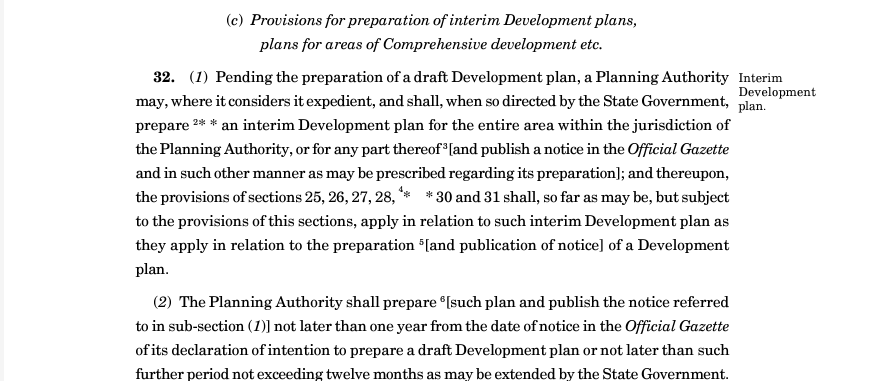

Section 32 of the Town Planning Act deals with the provision for an interim development plan. An interim development plan can be prepared by a Planning Authority in cases where a draft development plan is yet to be prepared. The section provides that a Planning Authority may prepare an interim development plan for the entire area within its jurisdiction or any part thereof, if it considers it expedient or is directed to do so by the State Government. The notice of the preparation of such plan must be published in the Official Gazette and in such other manner as prescribed. The provisions of sections 25, 26, 27, 28, 30, and 31 of the Act shall apply to the interim development plan, subject to the provisions of this section.
The Planning Authority is required to prepare and publish an interim development plan within a specific timeline. The timeline begins from the date when the Planning Authority declares its intention to prepare a draft development plan, which is published in the Official Gazette. The Planning Authority must complete this task within one year of this declaration.
However, the State Government has the power to grant an extension for a further period of up to twelve months, if necessary. During this period, the Planning Authority must prepare and publish the interim development plan, which should include maps and descriptive matter to explain and illustrate the proposals made in such a plan.
It is important to note that the interim development plan can only provide for matters mentioned in clauses (a), (b), and (c) of section 22 of the Town Planning Act. If necessary, the Planning Authority may include other matters or as directed by the State Government. The provisions of sections 25, 26, 27, 28, 30, and 31 shall apply in relation to the preparation and publication of an interim development plan, subject to the provisions of section 32.
An interim development plan can only provide for matters mentioned in clauses (a), (b), and (c) of section 22, which deal with land use, the reservation of land for public purposes, and the construction or improvement of streets. The Planning Authority may include other matters of section 22 if necessary, or if directed to do so by the State Government. The interim development plan shall consist of maps and descriptive matter as may be necessary to explain and illustrate the proposals made in such a plan.
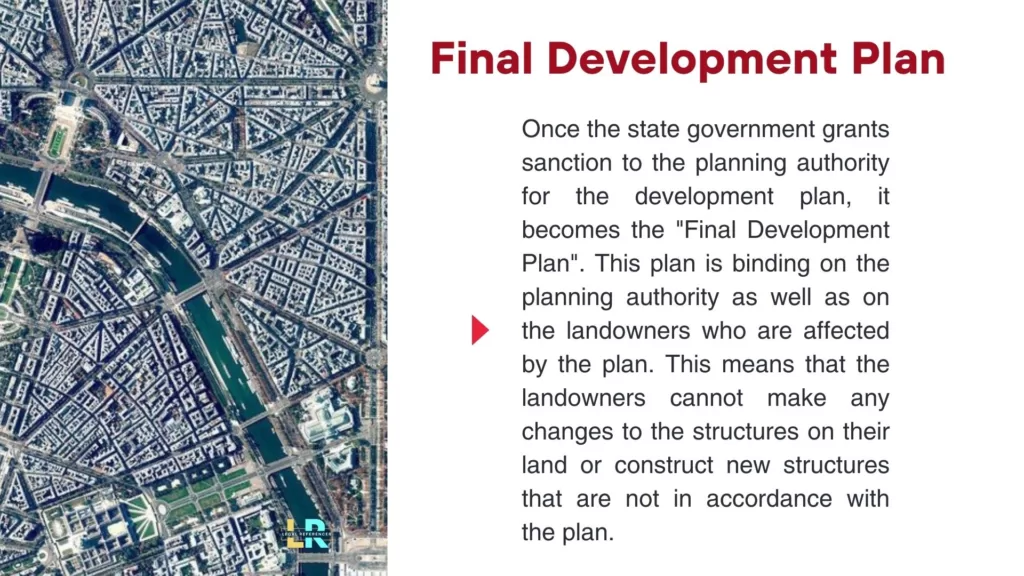
33. Plans for areas of comprehensive development:
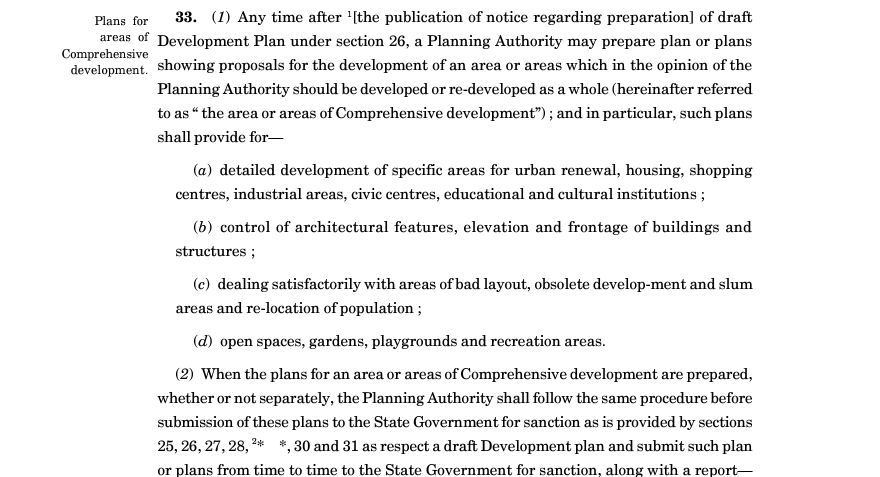

Section 33 of the Maharashtra Regional and Town Planning Act, 1966, deals with the preparation of plans for areas of comprehensive development. According to this section, a Planning Authority may prepare a plan or plans showing proposals for the development of an area or areas that should be developed or re-developed as a whole.
The plans for such areas should provide for a detailed development of specific areas for urban renewal, housing, shopping centers, industrial areas, civic centers, educational and cultural institutions. The plans should also include provisions for controlling architectural features, elevation, and frontage of buildings and structures, dealing satisfactorily with areas of bad layouts, obsolete development, and slum areas, and re-locating the population. Additionally, the plans should include provisions for creating open spaces, gardens, playgrounds, and recreation areas.
This section allows Planning Authorities to take a holistic approach to development by considering an entire area’s needs rather than just focusing on individual plots of land. It provides for the creation of detailed plans that address various aspects of development, including social and community infrastructure, in addition to the physical structures. By preparing plans for areas of comprehensive development, the Planning Authority can ensure that development occurs in a more organized, sustainable, and efficient manner.
This section describes the process for preparing and submitting plans for areas of comprehensive development to the state government for approval. The Planning Authority can prepare plans for the development of an area or areas that it believes should be developed or redeveloped as a whole, which will include detailed development proposals for urban renewal, housing, shopping centers, industrial areas, civic centers, educational and cultural institutions, control of architectural features, elevation and frontage of buildings and structures, dealing with bad lay-outs, obsolete development and slum areas, and open spaces, gardens, playgrounds, and recreation areas.
When the plans for an area or areas of comprehensive development are prepared, the Planning Authority must follow the same procedure as is provided by sections 25, 26, 27, 28, 30, and 31 for a draft development plan before submitting these plans to the state government for approval. The Planning Authority must also submit a report that explains the proposals and the stages of the development program by which it is proposed to execute the plan or plans and gives an appropriate estimate of the cost involved in executing the proposals of the plan or plans.
The State Government, after consulting the Director of Town Planning by notification in the Official Gazette, may approve the plan or plans for the area or areas of comprehensive development either without modifications or subject to such modifications as it considers necessary. The State Government must make a decision on the plan or plans within three months of receiving them from the Planning Authority, or within any further period that may be extended by the State Government.
34. Preparation of Development Plan for additional area:
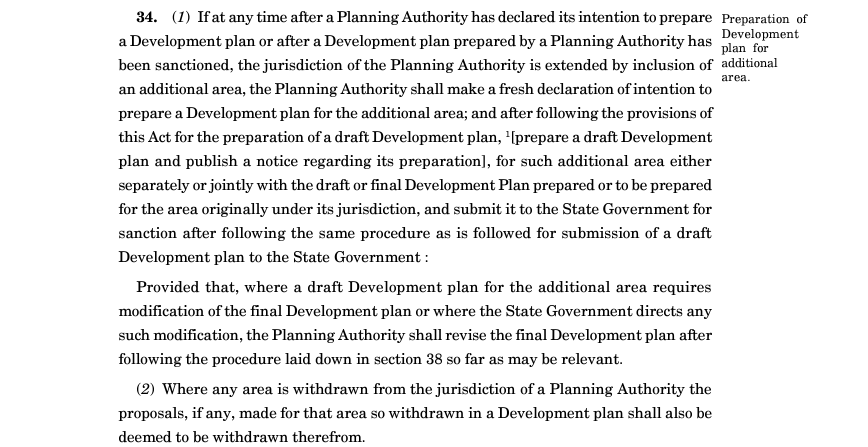
Section 34 of the Town and Country Planning Act explains the procedure that must be followed by the Planning Authority when the jurisdiction of the Planning Authority is extended by inclusion of an additional area.
According to this section, if an additional area is included in the jurisdiction of the Planning Authority after the declaration of intention to prepare a Development Plan or after the sanction of the Development Plan, the Planning Authority must make a fresh declaration of intention to prepare a Development Plan for the additional area. The Planning Authority must then prepare a draft Development Plan for the additional area, either separately or jointly with the draft or final Development Plan prepared or to be prepared for the area originally under its jurisdiction, and publish a notice regarding its preparation.
The Planning Authority must submit the draft Development Plan for the additional area to the State Government for sanction after following the same procedure as is followed for submission of a draft Development Plan to the State Government. If the draft Development Plan for the additional area requires modification of the final Development Plan, or if the State Government directs any modification, the Planning Authority must revise the final Development Plan after following the procedure laid down in section 38, as far as relevant.
35. Development Plans sanctioned by State Government before commencement of this Act:

If any Planning Authority has prepared a Development Plan which has been sanctioned by the State Government before the commencement of this Act, then such Development Plan shall be deemed to be a final Development Plan sanctioned under this Act.
36. Development Plan prepared prior to this Act:

Section 36 of the Town and Country Planning Act, 1971 deals with Development Plans that have been prepared prior to the enactment of this Act. The section states that if any Planning Authority has already prepared a draft Development Plan for the area within its jurisdiction before the commencement of this Act, that Development Plan shall be deemed to be a draft Development Plan for that area for the purposes of this Act.
In simple terms, this means that any Development Plan prepared by a Planning Authority before the Town and Country Planning Act, 1971 came into force would be considered a draft Development Plan for the purpose of this Act. The provisions of Chapter III of the Act, which relate to the submission of draft Development Plan to the State Government for sanction, would apply to these Development Plans, with any necessary changes.
Thus, the Planning Authority would need to follow the same procedure for submitting the Development Plan to the State Government for sanction, and the State Government would have the power to approve or modify the Plan as required under the Act. This provision ensures that existing Development Plans are brought under the ambit of the Act, and the provisions of the Act are applied to them accordingly.
37. 1[Modification] of final Development plan:

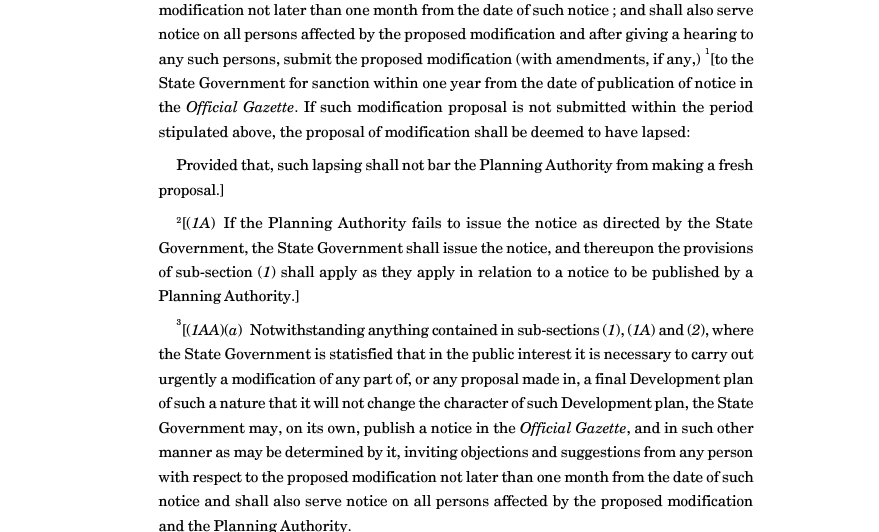
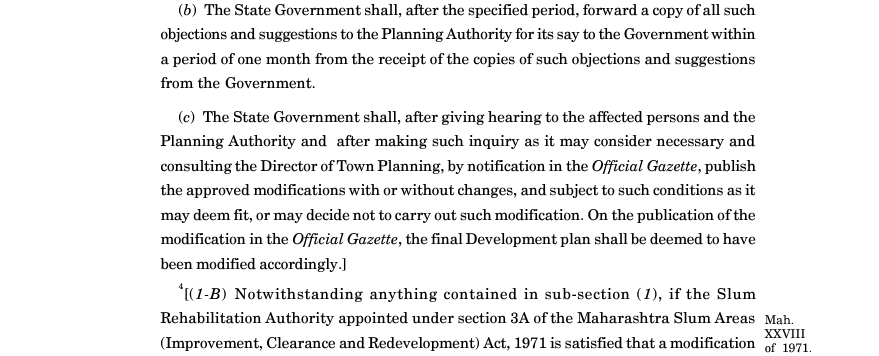
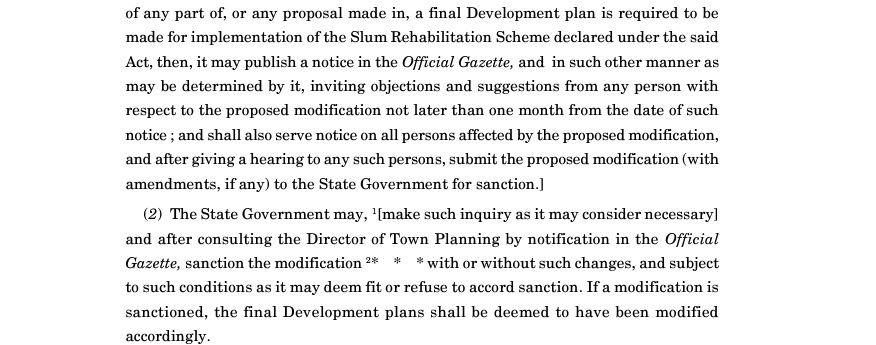
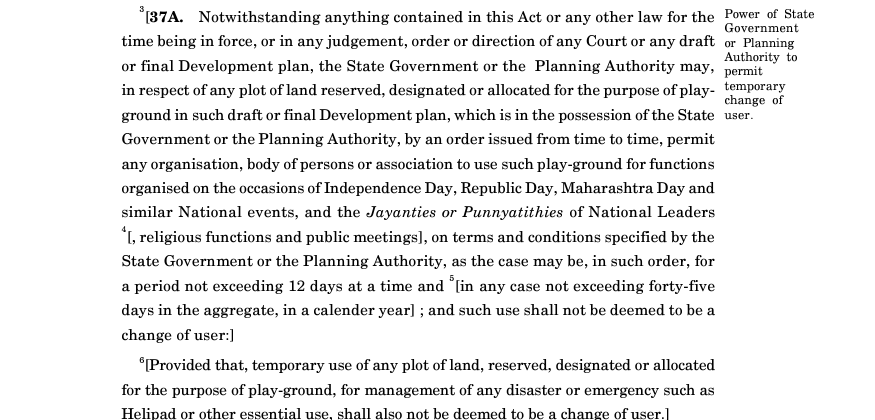
This section explains the process for modifying a final Development plan, which is a document that outlines the land use policies and regulations for a particular area.
If a modification is proposed, the Planning Authority (or the State Government, if directed) must publish a notice in the Official Gazette and in other appropriate channels, inviting objections and suggestions from the public within one month.
They must also serve notice to all persons affected by the proposed modification and hold a hearing to listen to any concerns they may have.
After this process, the proposed modification (with amendments, if any) must be submitted to the State Government for sanction within one year from the date of publication of notice in the Official Gazette. If the proposal is not submitted within this period, it will be considered lapsed.
However, the Planning Authority may still make a fresh proposal.
Additionally, if the Planning Authority fails to issue the notice as directed by the State Government, the State Government may issue the notice and the provisions of subsection (1) will apply as they would if issued by the Planning Authority.
It introduces a new sub-section, (1AA), which allows for an expedited process for urgent modifications that will not significantly alter the character of the Development Plan.
Under this sub-section, the State Government can publish a notice in the Official Gazette and other appropriate channels, inviting objections and suggestions from the public within one month.
They must also serve notice to all persons affected by the proposed modification and the Planning Authority.
Unlike the previous sub-sections, this process does not require the Planning Authority to initiate the modification or to submit it for sanction to the State Government. Instead, the State Government can carry out the modification on its own if it is deemed necessary in the public interest.
It is important to note that this expedited process is only applicable if the proposed modification is minor and will not substantially change the character of the Development Plan. If the modification is significant, the Planning Authority will still need to follow the regular process outlined in the previous sub-sections.
After the one-month period for objections and suggestions has elapsed, the State Government must provide a copy of all received objections and suggestions to the Planning Authority for its review.
The Planning Authority must consider these objections and suggestions and submit its response to the State Government within one month of receiving them.
After the objections and suggestions have been received and the Planning Authority has submitted its response, the State Government must then hold a hearing for the affected persons and the Planning Authority.
During the hearing, the State Government may conduct further inquiries as it deems necessary and consult with the Director of Town Planning.
Once the State Government has considered all the relevant factors, it will then make a decision to approve, modify, or reject the proposed modification. If the modification is approved, the State Government will publish it in the Official Gazette along with any necessary conditions.
Upon publication, the final Development Plan will be considered modified according to the approved changes.
It is important to note that this process provides an opportunity for public participation and ensures that modifications are made in the interest of the public and with the consultation of the relevant authorities.
Sub-section (1B) specifies that if the Slum Rehabilitation Authority determines that a modification to any part of the final Development Plan is required for the implementation of the Slum Rehabilitation Scheme declared under the Maharashtra Slum Areas (Improvement, Clearance, and Redevelopment) Act, 1971, it may publish a notice in the Official Gazette and invite objections and suggestions from affected parties.
The proposed modification, along with any amendments, will be submitted to the State Government for sanction after a hearing has been conducted for all affected parties.
The State Government may conduct an inquiry and consult with the Director of Town Planning before deciding whether or not to sanction the modification. If it is sanctioned, the modification will be published in the Official Gazette with any necessary conditions, and the final Development Plan will be considered modified accordingly.
This sub-section ensures that modifications required for the implementation of the Slum Rehabilitation Scheme can be made efficiently and effectively with the consultation of the relevant authorities and affected parties.
Jawahar Jyoti Co-operative Housing Society Ltd v. The State of Maharashtra & Ors“
Court ruling in a case involving a housing society in Maharashtra, India. The court observes that it is not permissible for any neighboring society to include the petitioner’s property in any scheme of development, redevelopment, or cluster development without notice to the petitioners, a hearing being afforded to them, and obtaining their specific consent in a lawful manner by passing a resolution at a general body meeting of the petitioner. The court states that no one can dictate how the petitioner’s property should be developed or redeveloped or in what proposal or project it should be included.
The court further states that the petitioner’s property will not be included in any Urban Renewal Project (URP) unless subject to the provisions of Appendix R1 or other regulations applicable to cluster development. In summary, the court ruling affirms the petitioner’s right to consent to any proposed development or redevelopment of their property and prohibits any neighboring society from including the petitioner’s property in any development scheme without their consent and following due process of law.
The provisions of Sub-section (1AA) of Section 37 of the Maharashtra Regional and Town Planning Act, which grants the State Government the power to make urgent modifications to any part of, or proposal made in, a final Development Plan. In such cases, the government is required to follow a specific procedure, which includes publishing a notice in the Official Gazette and inviting objections and suggestions from the public, as well as issuing a specific notice to persons affected by the proposed modification.
The general body of the Planning Authority also has a say in the matter when it comes to minor modifications. After the specified period for objections and suggestions has passed, the State Government must forward a copy of all objections and suggestions to the Planning Authority for its consideration. The Planning Authority then has one month to submit its say to the Government.
The passage emphasizes that the Government must consult the Director of Town Planning before arriving at its decision. This ensures that the proposed modification is in line with the principles of town planning and development. The case of Girish Vyas & Anr. v. State of Maharashtra & Ors. is cited as an example of the importance of following due process when making modifications to a Development Plan.
38. Revision of Development Plan:

Section 38 of the Maharashtra Regional and Town Planning Act, 1966 deals with the revision of a Development Plan by a Planning Authority. According to the section, a Planning Authority is allowed to revise the Development Plan at least once in 20 years from the date on which the plan has come into operation. In case the plan is sanctioned in parts, then the revision should be done at least once in 20 years from the date on which the last part has come into operation.
The section also states that the State Government can direct the Planning Authority to revise the Development Plan at any time. In order to revise the plan, the Planning Authority may need to carry out a fresh survey and prepare an existing land-use map of the area under its jurisdiction.
Furthermore, the provisions of sections 22 to 28, 30, and 31 of the Maharashtra Regional and Town Planning Act, 1966, which deal with matters such as the preparation and submission of the Development Plan, publication of the plan, objections and suggestions from the public, and modifications to the plan, shall apply to the revision of the Development Plan as well, as far as they can be made applicable.
Mohandas & Ors. v. The State of Maharashtra & Ors., which is related to Section 38 of the MRTP Act. The court observes that S.38 does not mandate that a revision of a development plan must be undertaken and finalized immediately before the expiry of 20 years from the date of the original final Development Plan. Instead, the period of 20 years is the maximum duration within which the planning authority can exercise its power of revision of the plan. This means that even if the revised Development Plan is issued 20 years after the initial final Development Plan, the original Development Plan would continue to hold under both plans, and the reservation in respect of the properties of the appellants would remain the same. In essence, the court is emphasizing that the 20-year timeline in S.38 is not a hard deadline for revising the development plan but rather a limit on when the planning authority may exercise its power to revise the plan.
39. Variation of town planning scheme by the Development Plan:

It provides that if a final Development Plan contains proposals that are different from, or modifications to, those made in a town planning scheme that was sanctioned by the State Government before the commencement of the MRTP Act, then the Planning Authority shall vary the scheme suitably under Section 92 to the extent necessary by the proposals made in the final Development Plan.
In simpler terms, if there is a town planning scheme that was already sanctioned by the State Government before the MRTP Act came into force, and a final Development Plan proposes changes to that scheme, then the Planning Authority must modify the scheme under Section 92 to incorporate the proposals made in the final Development Plan. This is to ensure that the town planning scheme is consistent with the final Development Plan.

40. Special Planning Authority for developing certain 2[notified areas:
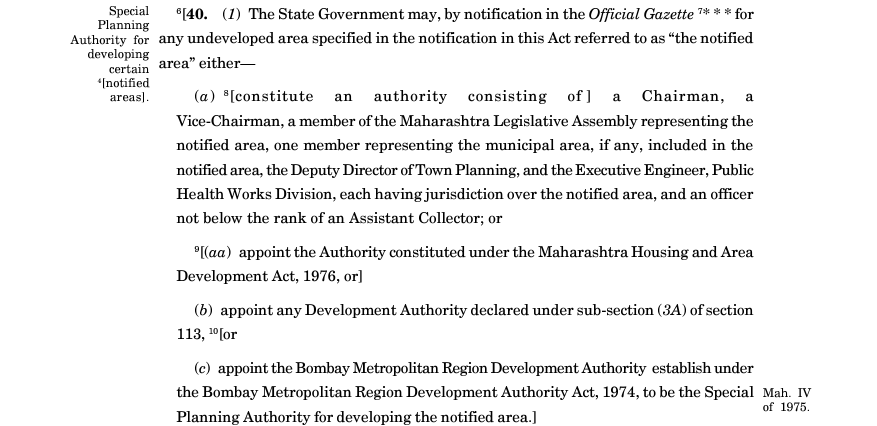
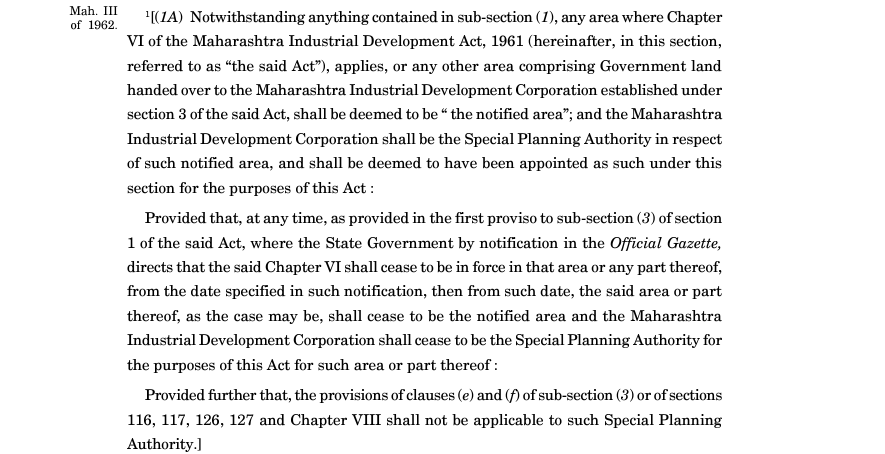
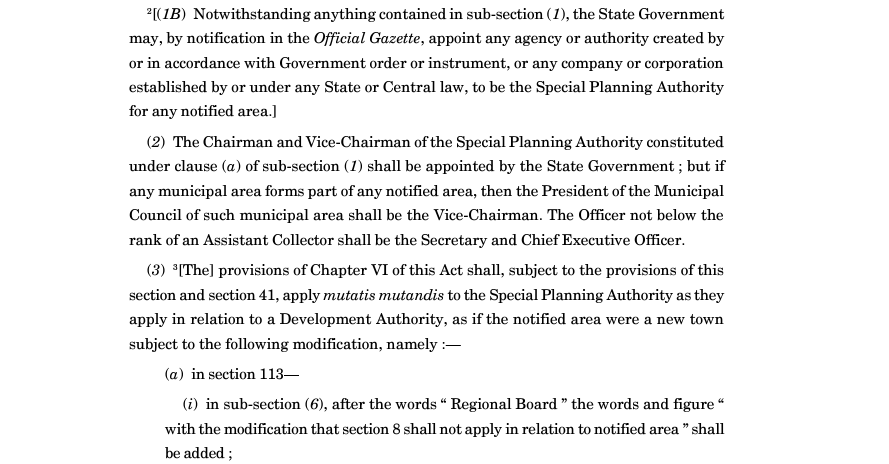
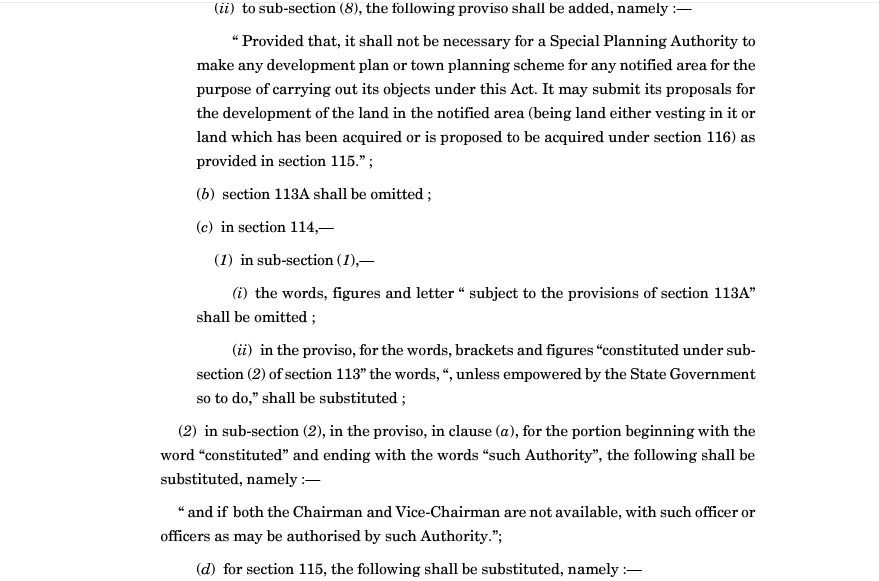


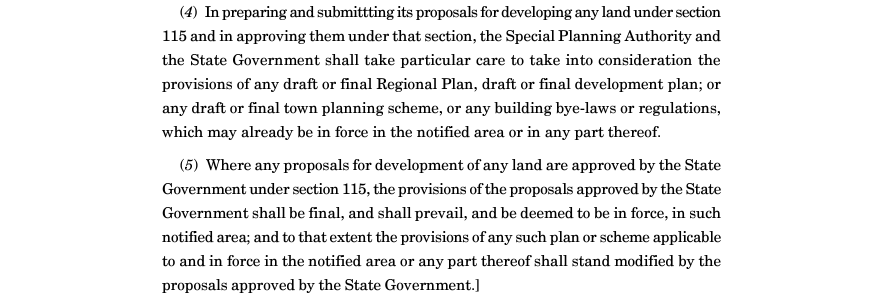
Mrs. Pusha Ghodvinde & Others v. State of Maharashtra & Others. In this case, the court observed that for the planned development of undeveloped villages and to provide necessary infrastructure, it was necessary to bring the area under the control of the Corporation and establish an effective planning mechanism. The jurisdiction of the VVCMC, as a local authority, had not been extended, and the government found it necessary to establish another Special Planning Authority (SPA) after receiving a request from CIDCO, which the government deemed deserving of acceptance.
The court noted that the replacement of one SPA with another was permissible under the MRTP Act if it was within the four corners of the Act and if the legal provisions were not challenged as unconstitutional or violative of the constitutional mandate. The petitioner did not challenge the legal provisions in question as unconstitutional or violative of the constitutional mandate enshrined in Parts IX and IX-A of the Constitution of India. In summary, the court upheld the legality of establishing a new SPA at the request of CIDCO.
Shahed Kamal & Ors. v. Pagarani Universal Infrastructure Pvt. Ltd. & Ors., 2022 NearLaw (BombayHC) Online 480, The case involves an appeal against an order passed by a single judge in an interim application in a dispute related to the sale of flats by a developer on land owned by the Mumbai Metropolitan Region Development Authority (MMRDA). The appellants had contended that the provisions of the Maharashtra Ownership Flats Act (MOFA) apply to the transaction, while the developer and MMRDA argued that MOFA does not apply to transactions on MMRDA land.
The court observed that it is entitled to express its views on the legal issues that arise before it, even if those issues were not raised by the parties. Under Order 41 Rule 22 of the Civil Procedure Code, the respondent can support the order of the lower court and argue that any finding against them on any issue ought to have been in their favor, even if they have not filed an appeal or cross-objection.
The court held that the MMRDA is entitled to argue that MOFA does not apply to transactions on its land, even though it did not file a cross-objection. The court set aside the observations of the single judge that MOFA applies to transactions on MMRDA land as incorrect as a matter of law. However, the court upheld the final order of dismissal of the interim application filed by the appellants.
Gera Developments Pvt. Ltd. and Anr. v. The State of Maharashtra, 2021 NearLaw (BombayHC) Online 2533, In this case, there were two writ petitions (W.P.-I and W.P.-II) filed by the petitioners, Gera Developments Pvt. Ltd. and Anr. The first writ petition (W.P.-I) sought a direction to the Maharashtra Industrial Development Corporation (MIDC) to grant an Occupancy Certificate and Building Completion Certificate to the petitioners for the building ‘Imperium Rise’ constructed in accordance with the sanctioned building plan(s). The second writ petition (W.P.-II) was filed by the petitioner seeking a direction for the realignment of the ring road to protect his property rights.
The court ruled that the cause of W.P.-I stood justified as the building ‘Imperium Rise’ was constructed as per the sanctioned building plans. Therefore, the court made the Rule in W.P.-I absolute and directed the MIDC and its officers to grant Occupancy Certificate and Building Completion Certificate to the petitioners within a period of three months if all legal formalities were completed.
Regarding W.P.-II, the court disposed of the same with the observation that the cause of its institution did not survive as the petitioners’ rights were protected by making the Rule in W.P.-I absolute. However, the petitioner was given the liberty to seek legal remedy in accordance with the law in case their property rights were affected due to future realignment of the ring road.
In summary, the court allowed W.P.-I and directed the MIDC to grant Occupancy and Building Completion Certificates, while W.P.-II was disposed of with the liberty to seek legal remedy if required.
41. Expenses of Special Planning Authority to be met by contribution by local authorities:


Section 41 of the Maharashtra Regional and Town Planning (MRTP) Act provides for the expenses of a Special Planning Authority (SPA) to be met by contributions from local authorities. The State Government has the power to determine the amount of contribution that each local authority, in whose area the SPA has been established, shall pay towards the expenses of the SPA.
The contribution can be in the form of a lump sum or in instalments, as specified by the State Government. The purpose of the contribution is to meet the expenses incurred by the SPA in carrying out the provisions of the MRTP Act.
The SPA is responsible for preparing development plans, zoning plans, and other planning activities in the area under its jurisdiction. The expenses incurred by the SPA include costs related to surveys, studies, planning, and execution of development projects.
The provision is aimed at ensuring that the SPA has adequate funds to carry out its functions effectively and efficiently. It also ensures that the financial burden of planning and development is shared by all the local authorities in the area.
Section 41 of the Maharashtra Regional and Town Planning Act, 1966 deals with the expenses of the Special Planning Authority, which is responsible for implementing and enforcing the provisions of the Act. Subsection (1) states that the State Government shall issue an order specifying the amount that each local authority in whose area the Special Planning Authority has been constituted shall contribute towards meeting the expenses of the Authority.
Subsection (2) requires the local authority to make the payment of the contribution amount to the Special Planning Authority within 30 days of receiving the order from the State Government. If the local authority fails to pay the contribution amount, the State Government is authorized to recover the amount from the local authority and pay it to the Special Planning Authority.
Subsection (3) provides that if a local authority fails to make the payment, the State Government can issue an order directing any person who has custody of any money on behalf of the local authority, such as an officer, treasurer, banker, or otherwise, to make the payment from such money. The person receiving the order must comply with it, and any payment made pursuant to the order shall be a sufficient discharge to such person from all liability to the local authority in respect of any sum or sums paid by him out of the local authority’s money held or received by him.
This section ensures that the expenses of the Special Planning Authority are met by contributions from local authorities and provides a mechanism for recovering any unpaid contribution amounts.
42. Implementation of plans:


